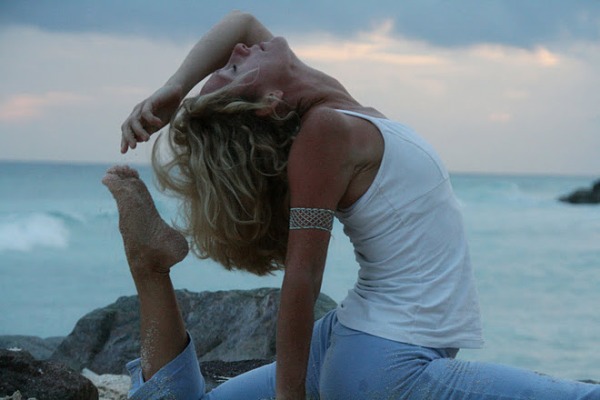
Practitioners of yoga asana are well aware of the fact that it is one of the most effective methods of curing anorexia, a typical form of eating disorder that mostly affects women. It has been found out by relevant research that yoga, which is a coordinated movement of the mind and the body, is more effective than aerobic exercises or weight training. Yoga prompts the mind to develop a healthy and toned body rather than keeping it occupied by thoughts of extreme starvation in order to get thinner and thinner.
1. Crab pose
How it works?
The basic posture of crab pose, which involves stretching of the chest and back bending helps in toning the lower back portion of the body. This stimulates the endocrine and the respiratory system and encourages their healthy functioning. It further tones and strengthens the body along with the back and the chest. The back bend involved in this posture further improves the flexibility of the spinal cord.
How to perform?
This is a standing posture. So, begin by standing on the floor with erect spinal cord and look straight. Keep your legs stretched out of your body with some gap in between them. Your hands must lie on either side of your body. Now, raise both your hands gradually over your head while breathing in. Continue further by bending backwards till you stoop down towards your back completely and touch the ground. When the hands touch the ground to support your posture, they must be positioned in a manner where the fingers face inwards. As you bend backwards, you must breathe out. Hold on to this posture for some times. After a few seconds, raise yourself from the posture and breathe in.
2. Pigeon pose
How it works?
This posture involves a number of stretches that stretches the muscles of the buttocks and the inner thighs. As a result, these muscles get toned.
How to perform?
Lie down on your chest on the floor. Keep your hands on either side of your body and look straight. Keep your legs stretched out of your body. Now, gradually bend your right leg and bring it closer to your body. Raise your body slowly and sit straight, keeping the posture of your legs intact. Support your posture with the two hands on either side and keep your spine erect. Breathe deep and hold the breathe for a few seconds and release breathe slowly.
3. Locust pose
How it works?
This posture induces strength of the abdominal muscles. It also gives endurance to the muscles of the lower back and improves flexibility of the spinal cord.
How to perform?
It is a yoga posture that demands sudden movement. Lie down on the floor in such a way that your chest touches the ground. Keep your legs stretched out and your hands on either side of your body. Now, with a soft jerk lift your legs together and keep them static at a point that you find convenient. Lift your head along with the upper torso too, as much as you can and look straight. Keep you hands connected to the floor and indulge in normal breathing. Hold on for a few seconds and then release.
4. Mountain pose
How it works?
This posture is often regarded as resting posture as it relaxes the tired muscles. It also strengthens the things, knees and ankles and tones the muscles of the buttocks and the abdomen.
How to perform?
Stand straight on the ground keeping your body straight and ensuring a gap equal to your hips in between your feet. Keep your hands relaxed, on the sides of your body. Now, breathe in and raise your hands gradually over your head. Finally, keep your palms connected over your head and breathe normally. After this lower your hands again while breathing out.
5. Goddess pose
How it works?
This posture is beneficial for the respiratory tract. It energizes your body when you do not feel rejuvenated. There are various types of goddess postures that impart vitality and encourage normal blood flow throughout the body. Thus, you regain back your lost zeal again.
How to perform?
Stand straight on the floor with a gap of one foot in between your legs. Now, lift your leg and put it further away as much as you can, in a manner where your feet lie outside your body, facing sideways. Simultaneously, stretch your arms out of your body and bend them from the elbows to face upwards. Keeps your spinal cord straight and look forward breathe normal.




